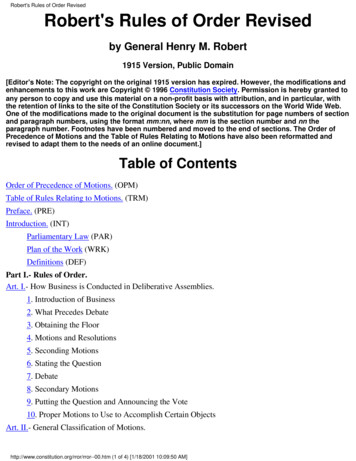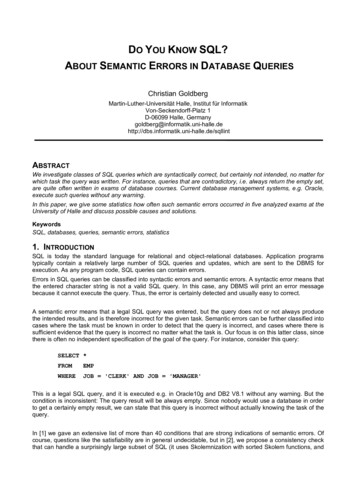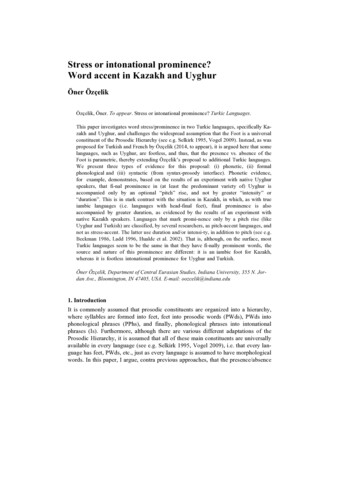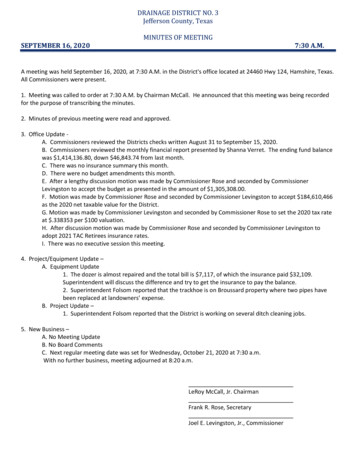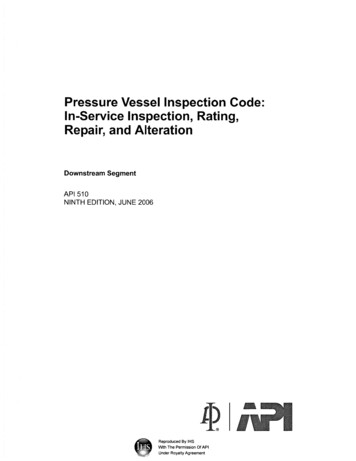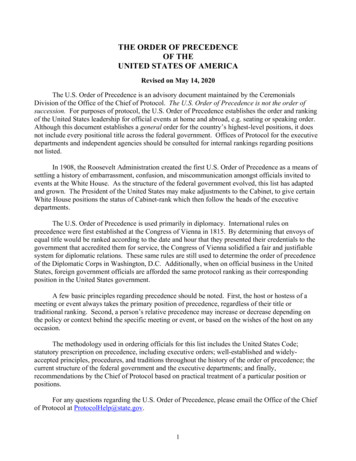
Transcription
THE ORDER OF PRECEDENCEOF THEUNITED STATES OF AMERICARevised on May 14, 2020The U.S. Order of Precedence is an advisory document maintained by the CeremonialsDivision of the Office of the Chief of Protocol. The U.S. Order of Precedence is not the order ofsuccession. For purposes of protocol, the U.S. Order of Precedence establishes the order and rankingof the United States leadership for official events at home and abroad, e.g. seating or speaking order.Although this document establishes a general order for the country’s highest-level positions, it doesnot include every positional title across the federal government. Offices of Protocol for the executivedepartments and independent agencies should be consulted for internal rankings regarding positionsnot listed.In 1908, the Roosevelt Administration created the first U.S. Order of Precedence as a means ofsettling a history of embarrassment, confusion, and miscommunication amongst officials invited toevents at the White House. As the structure of the federal government evolved, this list has adaptedand grown. The President of the United States may make adjustments to the Cabinet, to give certainWhite House positions the status of Cabinet-rank which then follow the heads of the executivedepartments.The U.S. Order of Precedence is used primarily in diplomacy. International rules onprecedence were first established at the Congress of Vienna in 1815. By determining that envoys ofequal title would be ranked according to the date and hour that they presented their credentials to thegovernment that accredited them for service, the Congress of Vienna solidified a fair and justifiablesystem for diplomatic relations. These same rules are still used to determine the order of precedenceof the Diplomatic Corps in Washington, D.C. Additionally, when on official business in the UnitedStates, foreign government officials are afforded the same protocol ranking as their correspondingposition in the United States government.A few basic principles regarding precedence should be noted. First, the host or hostess of ameeting or event always takes the primary position of precedence, regardless of their title ortraditional ranking. Second, a person’s relative precedence may increase or decrease depending onthe policy or context behind the specific meeting or event, or based on the wishes of the host on anyoccasion.The methodology used in ordering officials for this list includes the United States Code;statutory prescription on precedence, including executive orders; well-established and widelyaccepted principles, procedures, and traditions throughout the history of the order of precedence; thecurrent structure of the federal government and the executive departments; and finally,recommendations by the Chief of Protocol based on practical treatment of a particular position orpositions.For any questions regarding the U.S. Order of Precedence, please email the Office of the Chiefof Protocol at ProtocolHelp@state.gov.1
UNITED STATES ORDER OF PRECEDENCERevised 5/14/20201President of the United States12Vice President of the United States13Governor of a State1 – when in own state4Speaker of the House of Representatives5Chief Justice of the United States6ab7aFormer Presidents of the United States or their widows/widowers (by seniority of assumingoffice)Former Vice Presidents of the United States or their widows/widowers (by seniority ofassuming office)cAmerican Ambassadors Extraordinary and Plenipotentiary to foreign governments – when atpostSee also 29a in the order of precedence.American Ambassadors, Permanent Representatives or Representatives to internationalorganizations who hold Chief of Mission authority2 – when at post See also 29c in theorder of precedence.American Chargé d’Affaires ad interim – when at post8Secretary of Stateb9abcPresident, United Nations General Assembly – when in sessionSecretary General of the United Nations – when at the United NationsPresident, United Nations General Assembly – when not in session10Ambassadors Extraordinary and Plenipotentiary of foreign diplomatic missions3 to theUnited States (in order of presentation of credentials to the President of the United States)11 abcAssociate Justices of the Supreme Court (ranked by date of appointment)Retired Chief Justices of the United States (ranked by date of appointment)Retired Associate Justices of the Supreme Court, unless they resigned (ranked by date ofappointment)12abcdefghijkThe Cabinet (other than the Secretary of State), ranked according to date of establishment ofthe Department4, and as added by the President(*)5, as follows:Secretary of the TreasurySecretary of DefenseAttorney GeneralSecretary of the InteriorSecretary of AgricultureSecretary of CommerceSecretary of LaborSecretary of Health and Human ServicesSecretary of Housing and Urban DevelopmentSecretary of TransportationSecretary of Energy2
lmnopqrstu13 abcdef14Secretary of EducationSecretary of Veterans AffairsSecretary of Homeland SecurityChief of Staff to the President*Administrator, Environmental Protection Agency* (EPA)Director, Office of Management and Budget* (OMB)United States Trade Representative* (USTR)Administrator, Small Business Administration* (SBA)Director of National Intelligence* (DNI)Director, Central Intelligence Agency* (CIA)President pro tempore of the U.S. SenateSenate Majority LeaderSenate Minority LeaderSenate Majority WhipSenate Minority WhipSenators (by length of service; if the same, by the state’s date of admission into the Union oralphabetically by state)Governors of States1 – when outside their own states (Relative precedence amonggovernors, all of whom are outside their own state, is determined by each state's date ofadmission into the Union or alphabetically by state)See Appendix B.15 abcdeHouse Majority LeaderHouse Minority LeaderHouse Majority WhipHouse Minority WhipMembers of the House of Representatives (by length of service; if the same, by the state’sdate of admission into the Union or alphabetically by state)16 aDelegates or Resident Commissioners to the House of Representatives (non-votingmembers) from Territory of American Samoa, District of Columbia, Territory of Guam,Commonwealth of Puerto Rico, and United States Virgin Islands (by length of service) SeeAppendix C.Governors of Commonwealth of Puerto Rico, Territory of Guam, Territory of AmericanSamoa, United States Virgin Islands, and the Commonwealth of the Northern MarianaIslands (ordered by territory’s date of entering U.S. jurisdiction or alphabetically byterritory) See Appendix C.b17 abcdefghijkAssistants to the President and Deputy Chiefs of Staff (ranked by date of appointment)Assistant to the President for National Security Affairs (also known as the “NationalSecurity Advisor”)Assistants to the President and Senior Advisor (ranked by date of appointment)Assistant to the President and Chief of Staff to the Spouse of the PresidentAssistant to the President and Chief of Staff to the Vice PresidentAssistants to the President (ranked by date of appointment)Chair, Council of Economic AdvisorsChair, Council on Environmental QualityDirector, Office of Science and Technology PolicyDirector, Office of National Drug Control Policy (ONDCP)Chief of Protocol – when at the White House or accompanying the President3
See also 29b in the order of precedence.18 ab19 abcdef20abcdefghijklmnopqrstuAmerican Ambassadors, Permanent Representatives or Representatives to internationalorganizations who do not hold Chief of Mission authority6 – when at postSee also 29d in the order of precedence.Chargé d’Affaires ad interim assigned to foreign diplomatic missions to the United States(in order of date of assumption of this position)Former Secretaries of State (by seniority of assuming office)Former Cabinet Members (by seniority of assuming office)Former Senators (by leadership position, then length of service; if the same, by state’sadmission into the Union or alphabetically by state) See Appendix B.Former Governors of States – when in own state (ranked by seniority of assuming office)Former Governors of States – when outside their own states (relative precedence amonggovernors, all of whom are outside their own states, is determined by each state’s date ofadmission into the Union or alphabetically by state)See Appendix B.Former Members of the House of Representatives (by leadership position, then length ofservice; if the same, by state’s admission into the Union or alphabetically by state) SeeAppendix B.Deputies to Members of the Cabinet, ranked according to date of establishment of theDepartment, and as added by the President(*)7, as follows:Deputy Secretary of StateDeputy Secretary of the TreasuryDeputy Secretary of DefenseDeputy Attorney GeneralDeputy Secretary of the InteriorDeputy Secretary of AgricultureDeputy Secretary of CommerceDeputy Secretary of LaborDeputy Secretary of Health and Human ServicesDeputy Secretary of Housing and Urban DevelopmentDeputy Secretary of TransportationDeputy Secretary of EnergyDeputy Secretary of EducationDeputy Secretary of Veterans AffairsDeputy Secretary of Homeland SecurityDeputy Administrator, Environmental Protection Agency* (EPA)Deputy Director, Office of Management and Budget* (OMB)Deputy United States Trade Representative* (USTR)Deputy Administrator, Small Business Administration*(SBA)Principal Deputy Director of National Intelligence (DNI)*Deputy Director, Central Intelligence Agency* (CIA)21 abcdSecretary of the ArmySecretary of the NavySecretary of the Air ForceChairman, Joint Chiefs of Staff22 aChairman of the Board of Governors of the Federal Reserve and Commissioner of SocialSecurity of the Social Security Administration (SSA)4
bcdefg23 abcHeads of Federal Independent Agencies whom are at Level II of the Executive Schedule(ranked by agency’s creation date; if the same, by length of service).8See Appendix A.These agencies include, but are not limited to, the following: National Science Foundation(NSF), National Aeronautics and Space Administration (NASA), U.S. Agency forInternational Development (USAID), Nuclear Regulatory Commission (NRC), Office ofPersonnel Management (OPM), Millennium Challenge Corporation (MCC), U.S.International Development Finance Corporation (DFC) [Formerly Overseas PrivateInvestment Corporation (OPIC)]9Vice Chairman and Governors of the Federal Reserve System (by length of service)Deputy Commissioner, Social Security Administration (SSA)Deputy Director, Office of National Drug Control Policy (ONDCP)Director of the National Counterterrorism Center (NCTC)Deputy Heads of Federal Independent Agencies whom are at Level II of the ExecutiveSchedule (ranked by agency’s creation date, when the same, by length of service). SeeAppendix A.Under Secretaries of State and Counselor of the Department of State (as ranked by StateDepartment)Under Secretaries of Executive Departments, Treasurer of the United States, AssociateAttorneys General and Solicitor General (according to date of establishment of theDepartment; if more than one from a Department, then as ranked within the Department)Heads of Federal Departmental Agencies that report to the head of an Executive Department(ranked by date of establishment of the Department; if more than one from a Department,then as ranked within the Department)These agencies include, but not limited to: Director of Foreign Assistance at the Departmentof State; Defense Agencies, Federal Bureau of Investigation (FBI), Secret Service (USSS),Federal Aviation Administration (FAA), and Customs & Border Protection (CBP)24abcdef25 abcRetired Chairman, Joint Chiefs of Staff10Vice Chairman, Joint Chiefs of StaffChief of Staff, Army; Commandant of the Marine Corps; Chief of Naval Operations; andChief of Staff, Air Force (order is established by date of appointment)Chief, National Guard BureauCommandant of the Coast GuardCombatant Commanders (order is established by date of appointment)11Heads of Federal Independent Agencies whom are at Level III of the Executive Schedule(ranked by agency’s creation date; when the same, by length of service) See Appendix A.These agencies include, but are not limited to, the following: U.S. International TradeCommission (USITC), Export-Import Bank of the United States, Federal CommunicationsCommission (FCC), General Services Administration (GSA), Peace Corps (PC), U.S. Tradeand Development Agency (USTDA), National Foundation on the Arts and Humanities(NFAH), National Archives and Records Administration (NARA), Merit SystemsProtection Board (MSPB)Deputy Heads of Federal Independent Agencies whom are at Level III of the ExecutiveSchedule (ranked by agency’s creation date, when the same, by length of service). SeeAppendix A.Postmaster General5
26Lieutenant Governors – when in own State27Mayors1 of U.S. cities and the District of Columbia – when in own city28aHeads of International Organizations (ranked by their date of establishment) – when not atpostb29 abcdef30 abcdeThese organizations are including, but not limited to, the following: Inter-AmericanDevelopment Bank (IDB), International Monetary Fund (IMF), North Atlantic TreatyOrganization (NATO), Pan-American Health Organization (PAHO), Organization ofAmerican States (OAS), World Bank, United Nations (UN)Ambassadors or Permanent Representatives of foreign governments accredited tointernational organizations headquartered in the United StatesAmerican Ambassadors Extraordinary and Plenipotentiary to foreign governments – onofficial business in the United States or another country (ranked by the oath of office) Seealso 7a in the order of precedence.Chief of Protocol – when at the Department of State or at events outside the White HouseSee also 17k in the order of precedence.American Ambassadors, Permanent Representatives or Representatives to internationalorganizations who hold Chief of Mission authority2 – on official business in the UnitedStates or when representing the United States at a meeting of their international organizationaway from post (ranked by the oath of office)See also 7b in the order of precedence.American Ambassadors, Permanent Representatives or Representatives to internationalorganizations who do not hold Chief of Mission authority6 –on official business in theUnited States or when representing the United States at a meeting of their internationalorganization away from post (ranked by the oath of office) See 18a in the order ofprecedence.Career Ambassadors13Deputy Assistants to the President (ranked by date of appointment)Chief Judges and Circuit Judges of the United States Courts of Appeals (by length ofservice)Chief Judges and District Judges, United States District Courts (by length of service)Chief Judges and Judges of the United States Court of Military AppealsChief Judges and Judges of the United States Court of Appeals for Veterans ClaimsChief Judge and Associate Judges, United States Tax Court31American Chargé d’Affaires ad interim – on official business in the United States or whenrepresenting the United States32Under Secretaries of the Department of the Army, Navy, and Air Force (by date ofappointment)33 abcAssistant Secretaries (according to date of establishment of the Department, if more thanone from a Department, then as ranked within the Department)Chiefs of Staff to the Head of an Executive Department (according to date of establishmentof the Department, if more than one from a Department, then as ranked within theDepartment)Ambassadors at Large (according to date of establishment of the Department, if more thanone from a Department, then as ranked within the Department)6
defghijSpecial Envoys/Representatives (according to date of establishment of the Department, ifmore than one from a Department, then as ranked within the Department)Assistant Attorneys General (according to date of establishment of the Department, if morethan one from a Department, then as ranked within the Department)Legal Advisers of Executive Departments (according to date of establishment of theDepartment, if more than one from a Department, then as ranked within the Department)Special Assistants to the President, which includes the White House Social Secretary andSenior Directors of the National Security Council (NSC) (ranked by date of appointment)Heads of Federal Independent Agencies whom are at Level IV of the Executive Schedule(ranked by agency’s creation date, when the same, by length of service). See Appendix A.Deputy Director, Federal Bureau of Investigation (FBI)Deputy Heads of Federal Independent Agencies whom are at Level IV of the ExecutiveSchedule (ranked by agency’s creation date, when the same, by length of service). SeeAppendix A.34 abcdAssistant Administrators, Environmental Protection Agency (EPA)Assistant Administrators, Agency for International Development (USAID)Assistant United States Trade Representatives (USTR)Associate Administrators, Small Business Administration (SBA)35 abcComptroller General of the United StatesMembers of the Council of Economic Advisers (ranked alphabetically)Members of the Council of Environmental Quality36American Ambassadors-designate (in the United States)1437aMayors1 of U.S. cities – when not in own city (if multiple mayors present, rank by length ofservice)Mayor1 of the District of Columbia – when not in own city (if multiple mayors present, rankby length of service)Mayors1 of U.S. territories – when not in own city (if multiple mayors present, rank bylength of service)bc38 abcdefgh39 abcVice Chief of Staff, Army; Assistant Commandant of the Marine Corps; Vice Chief ofNaval Operations; and Vice Chief of Staff, Air Force (by date of appointment)Vice Chief of the National Guard BureauVice Commandant of the Coast GuardAssistant Secretaries and General Counsels of the Department of the Army, Navy, and AirForce (by date of appointment)Four Star Military Officers - General or Admiral (in order of seniority; retired officers rankwith but after active duty officers)Executive Secretary, National Security Council (NSC)Officers of the U.S. Senate, including the following: the Chaplain, the Party Secretaries, theSecretary of the Senate, the Sergeant at Arms, and the ParliamentarianOfficers of the U.S. House of Representatives, including the following: the Chaplain, theChief Administrative Officer, the Clerk of the House, and the Sergeant at ArmsThree Star Military Officers – Lieutenant General, Vice Admiral (in order of seniority;retired officers rank after active duty members)State Senators – when in own state (ranked by length of service, when the same, byalphabetical order by surname)State Representatives – when in own state (ranked by length of service, when the same, by7
d40 abcdef41 abcd42 abcdefghalphabetical order by surname)Former American Ambassadors/Chiefs of Diplomatic Missions (in order of presentation ofcredentials at first post)Chairmen or Heads of other federal Boards, Councils and Commissions not previouslylisted15 (ranked by creation date, when the same, by length of service)Librarian of CongressSecretary of the Smithsonian InstitutionChairman of the American Red CrossDeputy Chief of Protocol (ranked by date of appointment)Minister-rank officials assigned to foreign diplomatic missionsDeputy Under Secretaries of Executive Departments (according to date of establishment ofthe Department; if more than one from a Department, then as ranked within the Department)Principal Deputy Assistant Secretaries of Executive Departments (according to date ofestablishment of the Department; if more than one from a Department, then as ranked withinthe Department)Deputy Counsels of Executive Departments (according to date of establishment of theDepartment; if more than one from a Department, then as ranked within the Department)Two Star Military – Major General, Rear Admiral (in order of seniority; retired officersrank with but after active duty officers)Deputy Assistant Secretaries of Executive Departments (according to date of establishmentof the Department; if more than one from a Department, then as ranked within theDepartment)Deputy Assistant Secretaries and Deputy General Counsels of the Army, Navy and AirForce (by date of appointment)Directors of the National Security CouncilAmerican Consuls General to foreign governments – at postAmerican Deputy Chiefs of Mission – at postDeputy Permanent Representatives of foreign governments accredited to internationalorganizations headquartered in the United States – at postAssistant Chiefs of Protocol (ranked by date of appointment)Minister-Counselor-rank officials assigned to foreign diplomatic missions42 abChief Judge and Judges, United States Court of International TradeChief Judge and Associate Judges, United States Court of Claims43 aOne Star Military – Brigadier Generals, Rear Admirals (in order of seniority; retired officersrank with but after active officers)Directors of Offices of Executive DepartmentsConsuls General of foreign governments accredited to the United StatesCounselor-rank officials assigned to foreign diplomatic missionsMembers of the Senior Executive Service (SES) not holding previously listed positions (bydate of appointment, unless ranked differently as determined by the respective ExecutiveDepartment)Members of other federal Boards, Councils, and Commissions not previously listedDesk Officers of Executive DepartmentsFirst Secretary-rank officials assigned to foreign diplomatic missionsbcdefgh8
Endnotes and Further Explanation of Positional Rankings:1 Spousesof the President of the United States, the Vice President of the United States, Governors in their ownstate and Mayors in their own cities are afforded the same rank and courtesy that accompanies their spouses’positions at official functions. Spouses of other federal, state, or municipal government officials are accordedthe same rank as the Principal at official functions when they are attending together, and they are seatedaccordingly. This seating courtesy is the only ranking a spouse without title receives in the United States,unless the spouse himself or herself holds a separate position on the Order of Precedence.2 TheAmerican Ambassadors, Permanent Representatives or Representatives to international organizationswith Chief of Mission authority include the following: U.S. Mission to the United Nations (USUN) – NewYork; U.S. Mission to the African Union (USAU) – Addis Ababa; U.S. Representative to the Organization forSecurity & Cooperation in Europe with rank of Ambassador (OSCE) – Vienna; U.S. Mission to the ViennaOffice of the United Nations (UNVIE) – Vienna; U.S. Mission to the North Atlantic Treaty Organization(USNATO) – Brussels; U.S. Representative to the Organization for Economic Cooperation and Developmentwith the rank of Ambassador (USOECD) – Paris; U.S. Mission to the UN and Other InternationalOrganizations – Geneva; U.S. Mission to the European Union (USEU) – Brussels; U.S. Mission to theAssociation of Southeast Asian Nations (USASEAN) – Jakarta; U.S. Mission to the Organization of AmericanStates (USOAS) – Washington, DC.3 Diplomaticmissions refer to all bilateral missions and the delegations of the European Union and African Union.4 Forthe purposes of the Order of Precedence, any reference to “executive department” shall mean the CabinetDepartments led by the Cabinet Secretaries in #8 and #11a-n. See Appendix D for listing of executivedepartments by date of establishment.5 ThePresident may make changes in his or her administration to the Cabinet-rank positions listed in 11o-u.Positions listed with an (*) have been given the status of Cabinet-rank by the current presidentialadministration (as of March 2020).6 TheAmerican Ambassadors, Permanent Representatives or Representatives to international organizationswho do not hold Chief of Mission authority, and are given an Ambassador-rank only for the time served in therole, include the following: U.S. Representative to the Conference on Disarmament – Geneva; Representativeto the International Civil Aviation Organization (ICAO) – Montreal; U.S. Representative to the UN HumanRights Council (UNHRC) – Geneva; U.S. Representative to the United Nations Educational, Scientific andCultural Organization (UNESCO) – Paris; U.S. Representative to the Organization for the Prohibition ofChemical Weapons (OPCW) – The Hague; U.S. Representative to the United Nations Agencies for Food andAgriculture (FAO) – Rome.See endnote #4. The Deputies to Members of the Cabinet holding Cabinet-rank positions, marked with a (*),would also change based on the structure of the current Cabinet, as decided by the President.78 TheExecutive Schedule (EX), created by title 5 of the United States Code (5 U.S.C. § 5311), is the basic payschedule of the highest-level management positions in the United States government. All Executive Schedulepositions are statutory and require Presidential appointment and Senate confirmation, otherwise known as“PAS”. For purposes of order of precedence, the Head and Deputy Head positions of Independent FederalAgencies are ranked accordingly. See Appendix A.DFC was established in 2019 through the passage of Better Utilization of Investments Leading to Development(BUILD), Act. The BUILD Act combined the capabilities of the Overseas Private Investment Corporation(OPIC) and the Development Credit Authority which had previously been housed in the U.S. Agency forInternational Development (USAID).99
10 Retiredmilitary officers take precedence immediately after active-duty officers of the same position (or grade ifthe officer did not serve in a position that is explicitly listed) by the initial date of appointment to the position (orgrade). The positions for which this rule applies include the Chairman of the Joint Chief of Staff, the ViceChairman of the Joint Chief of Staff, the Chiefs of Staff of the Military Services, the Chief of the National GuardBureau, the Commandant of the Coast Guard, the Combatant Commanders, the Vice Chiefs of Staff of theMilitary Services, and Vice Chief of the National Guard Bureau, and the Vice Commandant of the Coast Guard.Precedence for retired military officers will be immediately after the highest position on the list for which anindividual served, except for retired Chairmen of the Joint Chiefs of Staff. Retired Chairmen of the Joint Chiefsof Staff. [Revised Department of Defense (DoD) Order of Precedence, July 15, 2016]11 Precedenceis established by date of appointment as a Combatant Commander. However, if that individualwas previously appointed as the Chairman of the Joint Chiefs of Staff, Vice Chairman of the Joint Chiefs ofStaff, Service Chief, or a previous Combatant Commander position, then the initial date of appointment to thepreviously held position will be used. Retired Combatant Commanders take precedence with but immediatelyafter active-duty Commanders by the initial date of appointment. [Revised Department of Defense (DoD)Order of Precedence, July 15, 2016]12 Forpurposes of order of precedence, the common practice for many municipal governments is to rank themayor immediately following the Governor of their state when in their own city.13 CareerAmbassadors refer to a specific and limited group of individuals. Under the 1980 Foreign Service Act(P.L. 96-465; 94 Stat. 2084), the President is empowered, with the advice and consent of the Senate, to confer thepersonal rank of Career Ambassador upon a career member of the Senior Foreign Service in recognition ofespecially distinguished service over a sustained period. In writing and upon retirement, Career Ambassadorsmay use the title Career Ambassador of the Foreign Service of the United States of America, Retired.An individual who has served as an Ambassador, appointed by the President, by and with the advice and consentof the Senate, may use the title of ambassador, as appropriate, upon retirement: U.S. Ambassador, Retired; orAmbassador-at-Large of the United States, Retired.This long-standing custom and practice, has established a tradition that persons who have served as anAmbassador, appointed by the President, by and with the advice and consent of the Senate, may continue to usethe title after such service in appropriate communications with others, may be referred to in communications andconversations by the title of Ambassador, and may be introduced to public audiences by the title. However, thisdoes not apply to officials who are given the rank of ambassador only for their tenure in that position or who arenot confirmed by the Senate.See Department of State Foreign Affairs Handbook for more H012430.html#H2439In the United States, Government officials who have been elected to public office or are appointed by thePresident of the United States with the advice and consent of the Senate are afforded the courtesy title of TheHonorable. These positions include, but are not limited to the President, Vice President, members of the Cabinet,Assistants to the President, Special Assistants to the President, Deputy and Under Secretaries of executivedepartments, Assistant Secretaries, American Ambassadors, Governors, and Mayors. Courtesy titles are notsalutations and used only in writing before the full name of a person. Additionally, it is custom in the UnitedStates for a person who has held the courtesy title of The Honorable to be addressed as The Honorable afterleaving a high-ranking position, unless they are removed from office or leaves in disgrace.14 Ambassador-designateis a diplomatic agent who has been nominated by the President of the United States andconfirmed by the Senate, but who has not presented copies of our credentials to the foreign government. SeeDepartment of State Foreign Affairs Handbook for more diplomatic 0.html#X61110
15 SeeAppendix A for the list of Federal Independent Agencies as noted in the United States Government Policyand Supporting Position
u Director, Central Intelligence Agency* (CIA) 13 a President pro tempore of the U.S. Senate b Senate Majority Leader c Senate Minority Leader d Senate Majority Whip e Senate Minority Whip f Senators (by length of service; if the same, by the state’s dat



